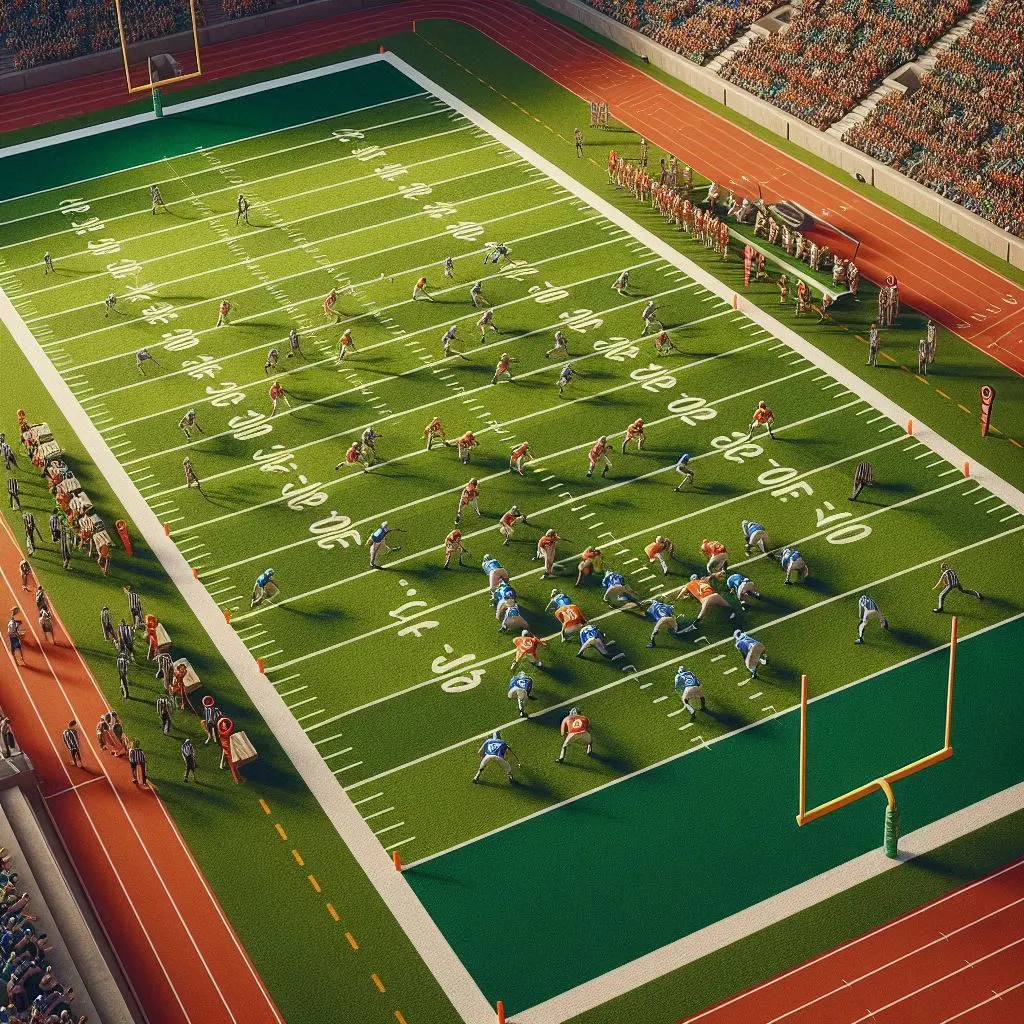Last updated on October 3rd, 2024 at 02:33 pm
Have you ever wondered how big 10 acres really is? 🌳 It’s hard to imagine such a large space without a relatable comparison. Well, if you love football, you’re in luck!
Understanding measurements can be tricky, especially when it comes to land sizes like acres. To make things easier, we’ll compare 10 acres to something most people know well: a football field. This comparison helps us visualize and grasp the size of 10 acres in a fun and engaging way.
In this article, you’ll discover:
- What an acre is and its history.
- The standard dimensions of a football field.
- How many football fields fit into 10 acres.
- Practical applications of this comparison.
By the end, you’ll have a clear picture of just how big 10 acres is. You’ll also see why using football fields as a reference makes understanding land measurements easier and more fun. Get ready to unveil the surprising ratio and impress your friends with your new knowledge! 🌟
Understanding Acres

What is an Acre?
An acre is a unit of area used in the U.S. and the UK. It’s commonly used to measure large plots of land. An acre is about 43,560 square feet. To help you imagine, picture a big square that is 208.71 feet on each side. 🌳
History of the Acre
The word “acre” comes from Old English. It originally referred to the amount of land a yoke of oxen could plow in one day. 📜 Over time, it became a standard measurement. Today, we still use acres to measure large spaces like farms, parks, and even residential properties. 🏡
Common Uses of Acres
Acres are used in many different contexts. Here are a few examples:
- Agriculture: Farmers use acres to measure fields and pastures. 🌾
- Real Estate: Real estate agents use acres to describe the size of properties for sale. 🏘️
- Parks and Recreation: Parks are often measured in acres to give a sense of their size. 🌳
Understanding acres helps us make sense of these large areas. It’s especially useful for anyone involved in land-related fields like farming, real estate, or city planning. 🌍
Knowing how many football fields fit into 10 acres can give us a better sense of space. So, let’s dive into the next section to learn about football field dimensions. 🏈
Football Field Dimensions

Standard Size of a Football Field
A standard American football field is a familiar sight to many. It measures 360 feet long and 160 feet wide. This size includes the end zones, which are essential parts of the field. The total area of a football field, including the end zones, is 57,600 square feet. 🏈
Breakdown of Different Parts of a Football Field
A football field has several key components:
- End Zones: Each end zone is 10 yards deep. Together, they add 20 yards to the field’s length. 🏆
- Sidelines: These run the length of the field and mark the boundaries. 📏
- Goal Lines: These are the lines the teams aim to cross to score touchdowns. 🏅
Variations in Size
While the dimensions mentioned are standard for professional and college football fields, high school football fields can be slightly different. However, the differences are minimal. For our comparison, we will stick with the standard dimensions. ⚽
Understanding these dimensions is crucial for comparing the size of a football field to 10 acres. When we know the size of one football field, we can easily calculate how many would fit into a given area. In the next section, we will perform this calculation step-by-step. 📐
Visualization
Visualizing the size of a football field can help put things into perspective. Imagine a large, rectangular green space with clearly marked lines, goal posts, and end zones. Now, picture this field and think about how many times you could fit it into 10 acres. The answer might surprise you! 🌟
This breakdown of a football field’s dimensions prepares us to understand how they relate to 10 acres. Next, we’ll dive into the math to find out how many football fields fit into 10 acres. 🧮
Calculating the Ratio

Basic Math
To understand how many football fields fit into 10 acres, we need some basic math. We know:
- 1 acre is 43,560 square feet. 🌳
- 1 football field (including end zones) is 57,600 square feet. 🏈
Step-by-Step Calculation
Let’s break down the calculation:
- Total Area in Acres: We start with 10 acres.
- Convert Acres to Square Feet: Multiply 10 acres by 43,560 square feet per acre.
- 10 acres×43,560 square feet per acre=435,600 square feet10 \text{ acres} \times 43,560 \text{ square feet per acre} = 435,600 \text{ square feet}10 acres×43,560 square feet per acre=435,600 square feet 📏
- Calculate the Number of Football Fields: Divide the total area in square feet by the area of one football field.
- 435,600 square feet÷57,600 square feet per football field=7.56435,600 \text{ square feet} \div 57,600 \text{ square feet per football field} = 7.56435,600 square feet÷57,600 square feet per football field=7.56 🏆
So, 10 acres can fit approximately 7.56 football fields.
Visualization
Visualizing this can make the concept clearer. Picture a large open space of 10 acres. Now imagine laying out football fields side by side. You would fit 7 full fields and a bit more than half of an eighth field. 🌳🏈
Practical Applications
Understanding this ratio has several practical applications:
- Real Estate: Knowing how many football fields fit into a plot of land helps in visualizing property sizes.
- Agriculture: Farmers can use this comparison to plan crop layouts or grazing areas.
- Recreation: City planners can use this to design parks and sports complexes.
Fun with Numbers
This simple calculation makes a complex measurement more relatable. It’s fun to think about large spaces in terms we see every day. Next time you hear about a 10-acre property, you’ll know it’s like having over seven football fields worth of space! 🌟
Now that we’ve done the math, let’s explore practical applications and fun comparisons in the next section. This will help us understand how useful and interesting these measurements can be. 🚀
Practical Applications

Real Estate
Understanding how many football fields fit into 10 acres can be very helpful in real estate. When looking at properties, it can be hard to visualize how big an acre is. By comparing it to something familiar like a football field, it becomes easier. For example:
- Buying Land: If you’re considering buying a 10-acre plot, knowing it’s equivalent to over 7.5 football fields can help you grasp its size better. 🏡
- Property Development: Developers can use this comparison to plan subdivisions or commercial spaces more effectively. 📊
Agriculture
Farmers and agricultural planners often deal with large areas of land. Understanding the size of 10 acres in terms of football fields can aid in various tasks:
- Crop Planning: Farmers can visualize how much space they have for planting different crops. For example, knowing that 10 acres is about 7.56 football fields helps in organizing fields. 🌾
- Grazing Areas: Livestock farmers can plan grazing areas more efficiently, ensuring they provide enough space for their animals. 🐄
Recreation
City planners and recreational organizers can also benefit from this comparison:
- Parks and Sports Complexes: When designing parks or sports complexes, planners can use the football field comparison to visualize space. For instance, a 10-acre park could include multiple sports fields, playgrounds, and open areas. 🌳⚽
- Event Planning: Organizers of outdoor events, like fairs or concerts, can use this knowledge to better plan the layout and facilities needed for a 10-acre venue. 🎪
Educational Uses
Teachers and educators can use this comparison to make learning about measurements more engaging:
- Classroom Activities: By explaining that 10 acres equals about 7.56 football fields, teachers can create fun math problems or projects. This helps students better understand large measurements. 🏫
- Field Trips: During field trips to parks or farms, teachers can help students visualize the size of the area by comparing it to football fields. 🚸
Urban Planning
Urban planners can use this comparison in various ways:
- City Layouts: When planning new developments or city expansions, knowing the size of 10 acres in football fields helps in designing efficient layouts. 🏙️
- Green Spaces: Planners can ensure that cities include ample green spaces by understanding how much area is needed. 🌿
Fun Comparisons
Understanding land size through football fields can lead to fun and interesting comparisons:
- Famous Sites: Comparing famous landmarks to football fields can make learning about geography and history more engaging. For example, you could compare the size of Central Park in New York to a certain number of football fields. 🌍
- Trivia: This knowledge can make for fun trivia questions or conversations. Imagine impressing your friends with your ability to visualize large spaces! 🌟
Summary
Understanding how many football fields fit into 10 acres is more than just a fun fact. It has practical applications in real estate, agriculture, recreation, education, and urban planning.
By using familiar comparisons, we can make sense of large measurements and use this knowledge in everyday life. 🌐
Next, let’s dive into some fun facts and comparisons to further explore the usefulness and interest of this measurement. 🚀
Fun Facts and Comparisons
Interesting Comparisons
Using football fields to measure large areas isn’t just practical—it’s fun too! Here are some interesting comparisons:
- Central Park: Central Park in New York City is about 843 acres. That means it could fit about 635.8 football fields! 🌳
- Disneyland: The Disneyland Park in California covers approximately 85 acres. So, it would be like having 64.6 football fields of fun and attractions! 🎢
Other Sports Fields
Football fields aren’t the only sports fields we can use for comparison:
- Tennis Courts: A standard tennis court is 2,808 square feet. You could fit about 155 tennis courts into 10 acres! 🎾
- Basketball Courts: A regulation NBA basketball court is 4,700 square feet. That means you could fit around 92.7 basketball courts into 10 acres! 🏀
Historical Sites
Understanding historical sites through the lens of football fields can make history more relatable:
- The White House Grounds: The White House and its surrounding grounds cover about 18 acres. This area would be about 13.6 football fields. 🏛️
- The Roman Colosseum: The Roman Colosseum occupies roughly 6 acres. That’s around 4.5 football fields! 🏟️
Fun Trivia
Here are some fun trivia questions to impress your friends:
- Question: How many football fields can fit in 10 acres?
- Answer: About 7.56 football fields! 🏈
- Question: How many acres does it take to fit 100 football fields?
- Answer: About 173.61 acres! 🌾
Teaching and Learning
Using football fields to understand measurements can be a great teaching tool:
- Interactive Lessons: Teachers can create interactive lessons where students measure their school playground in terms of football fields. 📏
- Math Problems: Incorporating these comparisons into math problems can make learning more engaging. For example, “If a park is 5 acres, how many football fields would fit into it?” 🧮
Planning Events
When planning events, knowing these comparisons can be helpful:
- Outdoor Festivals: For large outdoor festivals, planners can use the football field comparison to determine how much space is needed for stages, booths, and activities. 🎪
- Sports Tournaments: Organizers can plan how many games can be played simultaneously by understanding how many football fields are available. 🏆
Visualizing Large Areas
Visualizing large areas in terms of football fields can help in various fields:
- Environmental Studies: Scientists can use this comparison to explain the size of deforested areas or protected lands. 🌍
- Construction Projects: Engineers and architects can use this knowledge to better plan construction projects and understand the scope of large areas. 🏗️
Summary
Using football fields as a unit of measurement makes understanding large areas more relatable and fun. Whether you’re comparing famous landmarks, teaching students, or planning events, this method is both practical and engaging. 🌟
Next, let’s explore how to engage children and students with these fun and educational comparisons. 🚀
Engaging Children and Students
Teaching Tips
Making learning fun and relatable can help children grasp complex concepts more easily. Here are some teaching tips for using football fields to explain land measurements:
- Use Visual Aids: Create visual aids like diagrams or posters showing how many football fields fit into 10 acres. Visuals help kids understand better. 🖼️
- Storytelling: Incorporate stories or scenarios. For instance, tell a story about a farmer planning his 10-acre farm using football fields to decide where to plant crops. 📚
- Interactive Games: Design games where kids guess the number of football fields that fit into different spaces, like their school playground or local park. 🎲
Activities
Interactive activities can make the learning experience more engaging:
- Field Trips: Organize field trips to local parks or sports fields. Ask kids to estimate how many football fields fit into these areas. 🚌
- Math Projects: Create math projects where students calculate the number of football fields in various land areas. This reinforces their math skills while making learning fun. 🧮
- Creative Drawings: Have students draw maps of a 10-acre plot, dividing it into football fields. This activity combines creativity with learning. 🎨
Resources
Providing additional resources can enhance the learning experience:
- Books: Recommend books that explain measurements in fun ways, like “How Big Is a Foot?” by Rolf Myller. 📖
- Online Tools: Use online tools and apps that allow students to visualize measurements. Tools like Google Earth can help kids see real-world examples. 🌐
- Worksheets: Create worksheets with fun problems related to acres and football fields. This gives students hands-on practice. 📝
Classroom Discussions
Engage students in discussions to deepen their understanding:
- Open Questions: Ask open-ended questions like, “Why do you think comparing land to football fields helps us understand its size better?” This encourages critical thinking. 💬
- Group Projects: Assign group projects where students work together to measure and compare different areas. Collaboration enhances learning. 🤝
- Show and Tell: Let students share their own examples of large areas and how many football fields would fit into them. This makes the learning experience more personal. 📢
Real-World Examples
Using real-world examples makes learning more relevant:
- Local Parks: Compare local parks to football fields. For instance, if a nearby park is 5 acres, explain that it’s like having almost 4 football fields. 🏞️
- School Grounds: Measure the school grounds and relate it to football fields. This makes the concept more tangible for students. 🏫
- Famous Landmarks: Discuss famous landmarks and their sizes in terms of football fields. This adds an interesting twist to geography lessons. 🌍
Fun Comparisons
Making fun comparisons can spark students’ interest:
- Movie Sets: Compare the size of movie sets or theme parks to football fields. For example, explain that the Hogwarts castle set in the Harry Potter movies covers about 2 acres, which is roughly 1.5 football fields. 🎬
- Space: Talk about how many football fields would fit into a sports stadium or other large venues. This helps students visualize large spaces better. 🏟️
- Animals: Compare the grazing areas for different animals to football fields. For instance, explain that a 10-acre pasture for cows is like having 7.56 football fields. 🐄
Summary
Engaging children and students with fun and interactive methods helps them understand complex concepts like land measurements. By using football fields as a comparison, educators can make learning more relatable, enjoyable, and effective. 🌟
Next, we’ll conclude the article with a summary and key takeaways. 🚀
Conclusion
Summary
In this article, we’ve explored the intriguing comparison between 10 acres and football fields. By breaking down the math and understanding the dimensions of a football field, we’ve discovered that 10 acres is equivalent to about 7.56 football fields. This comparison helps make the concept of large land areas more relatable and easier to visualize. 🌳🏈

Matthew Porter is a seasoned sports journalist with a flair for storytelling. At SpoortsUp.com, he captivates audiences with his vivid narratives and in-depth coverage of major sporting events. His commitment to uncovering the stories behind the scores makes every article a must-read for sports enthusiasts.











